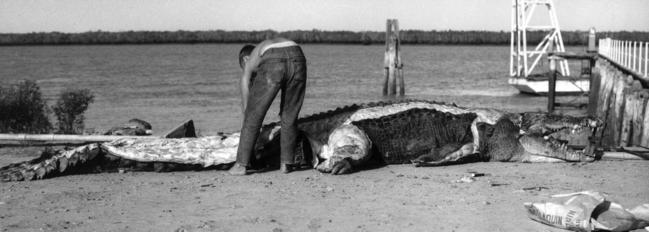Floods spark warning as hunters reflect on giant croc catch
FISHERS have been reminded to be aware of crocs being more active after the floods, as the 50th anniversary of a giant 6.09m croc catch at Port Alma nears.
Gladstone
Don't miss out on the headlines from Gladstone. Followed categories will be added to My News.
50 years since monster croc was caught north of Gladstone
WITH the rain and floods comes a temporary increase of mobility for wildlife such as snakes and crocodiles.
The Department of Environment and Heritage Protection is reminding fishers to be aware of crocs.
DEHP wildlife director Rebecca Williams advised fishers not to discard fish frames and bait at boat ramps and estuarine fishing spots
"In croc country, (these) encourage crocs to come into the area where the scraps are discarded," she said.
"When rangers investigate crocodile reports they are often confronted with fish and bait scraps."
DEHP wildlife operations manager Mike Devery said crocodiles were known to occur north of the Boyne River, although there were some historical records from as far south as the Logan River.
"As Gladstone is within known crocodile country, it would not be unusual for crocodiles to be observed," he said.
"Although most commonly seen in tidal reaches of rivers, they also occur in freshwater lagoons, rivers and swamps hundreds of kilometres inland from the coast.
"The records of crocodile numbers within Gladstone Harbour in the 1950s and 1960s have not survived, therefore we cannot compare the numbers from then to now.
"We do know that the population of crocodiles was probably at its lowest at the time when crocodile harvesting ceased in the mid-1970s," Mr Devery said.
As Gladstone is within known crocodile country, it would not be unusual for crocodiles to be observed
"Usually, crocodile sightings increase with expanding urban development as more people live and recreate within a particular region.
"This doesn't necessarily mean an increase in crocodile numbers - just more incidences of people observing and reporting them."
Mr Devery said crocodiles were more active and mobile in summer, which was their breeding season.
"When this coincides with flooding, we can expect an increased likelihood of sightings because crocodiles prefer quieter waters and will be trying to move out of fast-flowing areas," he said.
"It's important for people to be aware that this can lead to crocodiles being seen in areas where they normally would not go. In most circumstances the crocodile will just be moving through."
This month, Gladstone fisherman Johnny Mitchell reported seeing a crocodile in The Narrows, just north of Ramsay's Crossing, and sightings in Rockhampton's Fitzroy River are common.
Gladstone locals yesterday took to The Observer website to say that sightings in the area were not unusual.
"In the '50s and '60s they were common," one commented.
DEHP has multiple reports of crocodile sightings on their website ehp.qld.gov.au
These include 83 confirmed and 261 unconfirmed in 2012.
A 3.5m croc was found last year in the Mary River near Maryborough.
Rumoured Gladstone sightings
- Curtis Island mangroves.
- Top end of The Narrows.
- Calliope River near the power station and river mouth.

50 years since monster croc caught north of Gladstone
IT HAS been nearly 50 years since a 6.096m crocodile was caught by Sydney hunters Hugo Schmidt, Edgar Jakstadt and Tony de Jraa at Port Alma, north of Gladstone.
It was April 23, 1963, when the large crocodile cruised past the main wharves.
At the same time the three men, who happened to be crocodile hunters arriving from Sydney in their yacht, had pulled into the port for much-needed repairs to their vessel's keel.
"At that time we stayed in Port Alma for a month fixing a new keel on our boat," Mr Schmid said.
Mr Schmid, who was also a photograper, shot the croc after he heard a man shouting from the main wharf that there was a crocodile in the water.
"I jumped up and grabbed my .303 rifle and shot the animal in the head," Mr Schmid said.
He estimated the crocodile to be 20 feet long (6.096m).
The Northern Territory holds the scientifically verified record for having the largest crocodile named Sweetheart.
Sweetheart, a 5.1m saltwater crocodile, and weighing 780kg, was responsible for a series of attacks on boats between 1974 and 1979. Sweetheart attacked outboard motors, dinghies, and fishing boats.
In July 1979, Sweet-heart was finally caught alive by a team from the Territory Parks and Wildlife Commission, but drowned while being transported when it became tangled with a log.
The crocodile's mounted body is now on permanent display at the Museum and Art Gallery of the Northern Territory.


